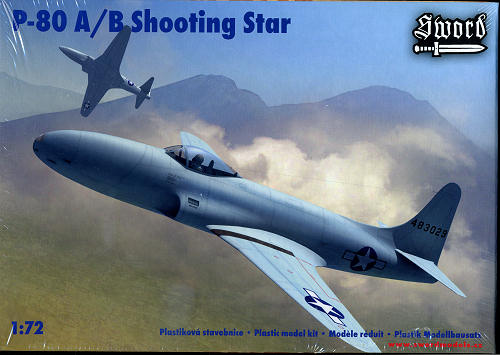
| KIT #: | SW72041 |
| PRICE: | $32.95 SRP |
| DECALS: | Four options |
| REVIEWER: | Scott Van Aken |
| NOTES: | Multi-media kit with resin parts |

| HISTORY |
The Lockheed P-80 Shooting Star was the first jet fighter used operationally by the United States Army Air Forces, and saw extensive combat in Korea with the United States Air Force as the F-80. As one of the world's first successful turbojet-powered combat aircraft, it helped usher in the "jet age" in the USAF and other air forces worldwide. One of its claims to fame is in training a new generation of pilots, especially in its closely-related, and actually faster, T-33 Shooting Star trainer development.
The F-80 arrived in Europe just a tad too late to take part in the fighting with several being sent to Italy in late May/early June of 1945. As the Luftwaffe was all but gone from Italy, there would have been little opportunity for air to air fighting anyway. The F-80A quickly entered unit service and was flown by several jet 'aerobatic' teams in the late 1940s. The F-80B soon followed with a number of improvements, including an ejection seat and improved navigational avionics and a radar gun sight. This was followed by the ultimate F-80, the F-80C, a jet that was now a fully mature weapons system.
Shooting Stars first saw combat service in the Korean War, employing both the F-80C variant and RF-80 photo-recon variants. The first jet-versus-jet aircraft battle took place on 8 November 1950 in which Lieutenant Russell J. Brown, flying an F-80, claimed a MiG-15 shot down. Despite the initial claim of success, the straight-wing F-80s were inferior in performance to the MiGs and were soon replaced in the air superiority role by the swept-wing F-86 Sabre. When sufficient Sabres were in operation, the Shooting Star was assigned to ground attack missions, advanced flight training duties and air defense in Japan. By the end of hostilities the only F-80s still flying in Korea were photo-recon variants.
| THE KIT |
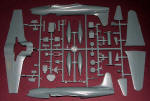 Sword's F-80A/B is the fourth boxing of this basic kit. The F-80C and RF-80A were previewed earlier and I never got the chance to look over the T-33 kit. This kit has what appear to be a number of new parts for this boxing and the sprues layout is quite different. The kit
Sword's F-80A/B is the fourth boxing of this basic kit. The F-80C and RF-80A were previewed earlier and I never got the chance to look over the T-33 kit. This kit has what appear to be a number of new parts for this boxing and the sprues layout is quite different. The kit 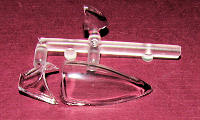 ncludes one sprue of grey plastic, a clear sprue with a separate windscreen, nose light, and canopy, and a small bag of resin parts. These resin parts consist of the center main gear well, complete nose gear well, bang seat for the F-80B version, gun sight and landing light section. The resin is superbly done with considerable detail. It would have been nice to have the cockpit tub also in resin as the plastic detailing, while good, is not as nice as it would have been in resin.
ncludes one sprue of grey plastic, a clear sprue with a separate windscreen, nose light, and canopy, and a small bag of resin parts. These resin parts consist of the center main gear well, complete nose gear well, bang seat for the F-80B version, gun sight and landing light section. The resin is superbly done with considerable detail. It would have been nice to have the cockpit tub also in resin as the plastic detailing, while good, is not as nice as it would have been in resin.
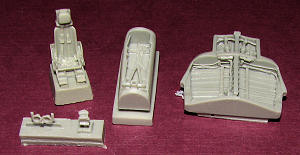 Detailing on the plastic parts is excellent with fine engravings. I found no flash on the pieces, which would have been the case had these parts not been specifically tooled for this variant. I noted that the sprue attachment areas intrude slightly into most of the parts so some care will be needed to remove the bits and to clean up these attachment areas. There are blanking plates for the intakes to prevent see-through and the kit comes with standard tip tanks. Speed brakes are separate items as well with all the appropriate retraction struts included. This is true of the main and nose gear legs. The nose gear has a separate wheel/tire piece. Two styles of nose wheel are provided, though you'll probably want to use the early version that doesn't match the pattern on the main wheels. There is no under wing ordnance as these were pure fighters. I should also mention that the Skyblazers option would have flown its performances without the tip tanks.
Detailing on the plastic parts is excellent with fine engravings. I found no flash on the pieces, which would have been the case had these parts not been specifically tooled for this variant. I noted that the sprue attachment areas intrude slightly into most of the parts so some care will be needed to remove the bits and to clean up these attachment areas. There are blanking plates for the intakes to prevent see-through and the kit comes with standard tip tanks. Speed brakes are separate items as well with all the appropriate retraction struts included. This is true of the main and nose gear legs. The nose gear has a separate wheel/tire piece. Two styles of nose wheel are provided, though you'll probably want to use the early version that doesn't match the pattern on the main wheels. There is no under wing ordnance as these were pure fighters. I should also mention that the Skyblazers option would have flown its performances without the tip tanks.
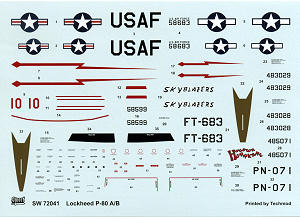 Instructions are well done with generic color references and indications as to what to paint the small bits during construction. Detail alignment information is given to be sure that we get things properly in position. There are four options. Two F-80As, in overall Pearl Grey (FS 16492). The box art plane is one of the P-80As sent to Italy in 1945 while the second is "Houston Hurricane" of the 412 FW at March AFB in 1946. This plane has a white tip to the nose. The other is a F-80B from the Skyblazers aerobatic team in Germany during 1949-50. This aircraft is in unpainted metal. The second F-80B is from the 22nd FBS/36 FBG in Europe during 1950. It is also in unpainted metal. I should mention that the painting profiles show the F-80B nose for the F-80A options, so don't let that confuse you. The decals are superbly printed by Techmod and include both wing walk and nose anti-glare panels in addition to a full stencil suite.
Instructions are well done with generic color references and indications as to what to paint the small bits during construction. Detail alignment information is given to be sure that we get things properly in position. There are four options. Two F-80As, in overall Pearl Grey (FS 16492). The box art plane is one of the P-80As sent to Italy in 1945 while the second is "Houston Hurricane" of the 412 FW at March AFB in 1946. This plane has a white tip to the nose. The other is a F-80B from the Skyblazers aerobatic team in Germany during 1949-50. This aircraft is in unpainted metal. The second F-80B is from the 22nd FBS/36 FBG in Europe during 1950. It is also in unpainted metal. I should mention that the painting profiles show the F-80B nose for the F-80A options, so don't let that confuse you. The decals are superbly printed by Techmod and include both wing walk and nose anti-glare panels in addition to a full stencil suite.
| CONCLUSIONS |
It is about time we had an early Shooting Star. While it wasn't all that difficult to do an F-80B from the C model kits, doing a proper F-80A required considerably more work. Now we have one and based on the F-80C I built a while back, it will be a real beauty.
| REFERENCES |
May 2011
Thanks to Squadron Products for the preview kit. Get yours today at your local shop or on-line retailer
If you would like your product reviewed fairly and fairly quickly, please contact the editor or see other details in the Note to Contributors.